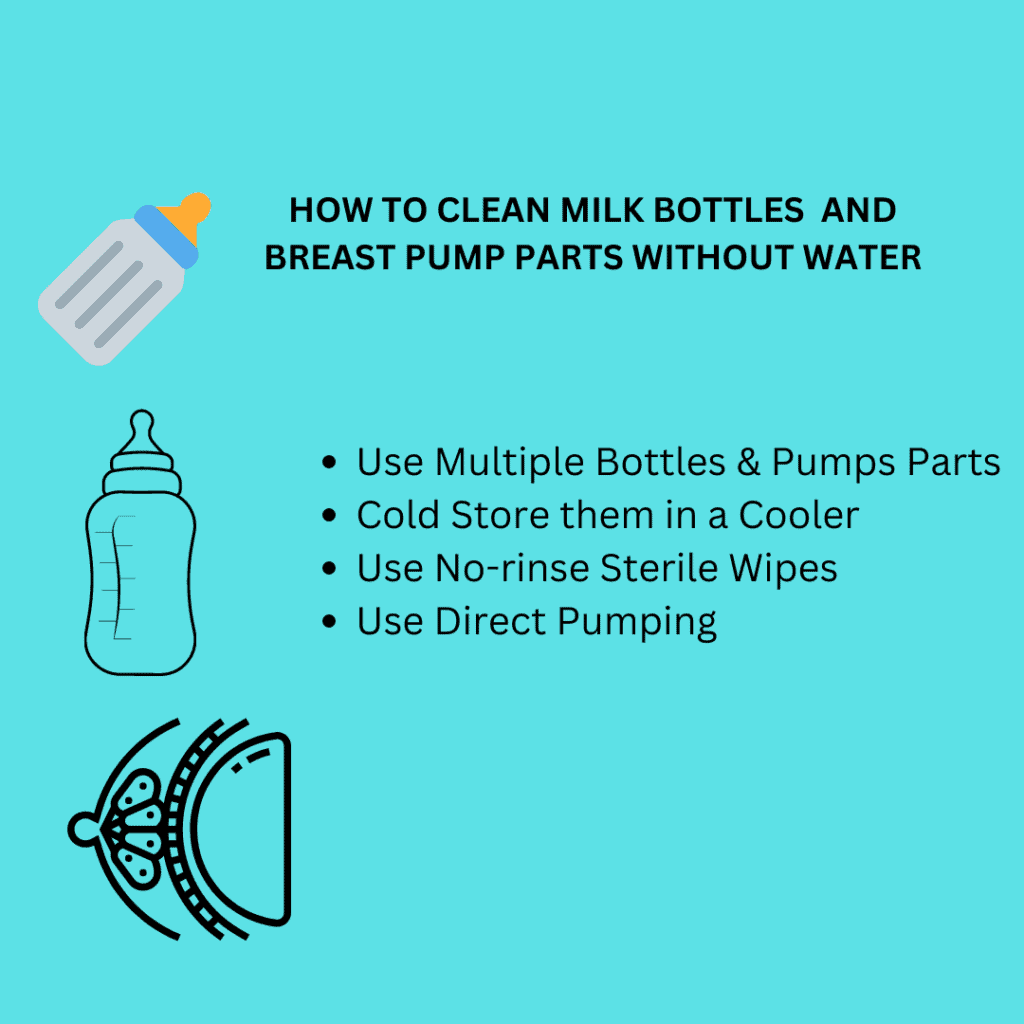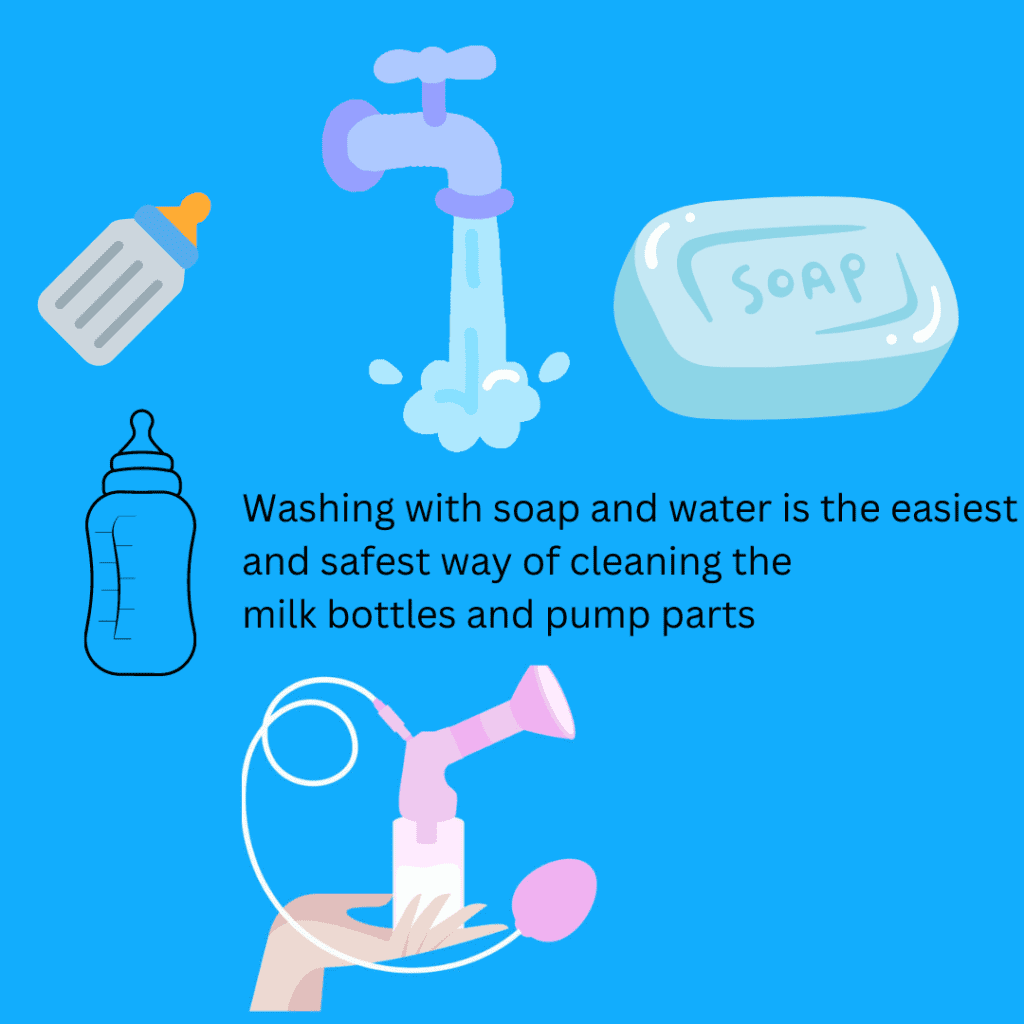How Often Should I Clean Bottles & Pump Parts
Keeping the milk bottles, the pump, and the pump parts clean is very important for hygiene. It keeps the milk safe for consumption by the baby as feeding the baby unhygienic milk or unclean bottles may cause stomach discomfort among other issues.
Also observing high levels of hygiene with the milk bottles and pump parts avoids the expressed milk from going bad, which is very important as the baby needs every ounce of the breast milk for nourishment.
However, how often or how many times you should wash the milk bottles and the pump parts is relative and varies from one mom to another. Some moms who stay at home or have access to water wash the pumping bottles and pump after every session, every single day.
CDC has a new recommendation that encourages moms who pump breast milk to clean the bottles and pumps after every use. Read it here.
While it is recommended and reasonable to clean these parts after every use, it is not quite necessary especially if you do not have access to clean water. You can maintain high hygiene for these bottles and parts without water.
It is therefore not wrong to reuse the bottles and parts. However you can only reuse them for up to three before you MUST clean or sterilize the parts.
However, it is not necessary to wash the pumping bottles and pump them after every use or after every pumping session. The important thing is to keep them sterilize between session after each pump until you can wash and clean the pump, bottles, and parts in the evening with soap and water.
Simple Safe Ways of Cleaning Milk Bottles & Pump Parts
There are several ways that working moms who pump breast milk for their children can keep the milk bottles and pump parts clean safely and conveniently.
1.Using Soap and Water. One of the easiest ways you can clean milk bottles, and pump parts is using soap and water. Washing by hand using a sponge, wash cloth or a brush will make sure all parts are clean.
You can warm the water for a more thorough wash. Ensure that you reach all the areas, especially on the small parts of the pump. There are long brushes specific for washing milk bottles and pump parts that will help in this.
After washing ensure you rinse thoroughly with running clean water. After this, some moms go a further step to store the bottles and pump parts in microwave steam bags to sterilize them.
2. Boiling the Parts
Another way you can safely and easily clean your bottles and pump parts is by boiling them. Boiling is one of the traditional and simplest ways of sterilizing them. You do this by simply bringing water to a boil then putting your milk bottles and pump parts in it to kill the germs.
Approved Ways of Cleaning Bottles & Pump Parts without Water
Most working moms have no access to clean water during the day. If you pump from work or travel a lot, you may not have water that you can wash the milk bottle or the pump parts with until later in the evening.
Therefore it becomes important for you to keep your milk bottles and breast pump parts clean, even without water. Some of the ways you can clean milk bottles and breast pump parts without water include;

1. Using Multiple Bottles & Pumps Parts
One way that you can maintain the hygiene of your pumping sessions without cleaning the parts is to have multiple milk bottles and pump parts. Since the intention is not to reuse the bottles or pumping parts, you will need multiple pairs to match the number of pumping sessions.
If you pump twice at work, or when you are traveling, then you need two sets of the pumping bottles and the pump parts. You will then use each set for each session of pumping without reusing them. The option is costly but a sure way of ensuring hygiene has been observed and the breast milk is safe when you do not have access to water.
2. Keeping Bottle and Pump Parts in a Cooler
Keep the pumping tools cold in the cooler to keep them sterile if you have no water to wash them. Many working moms put pump parts in the fridge between uses at work because they don’t have access to water for cleaning. The cold temperature in the cooler are enough to kill the germs so it is safe to use.
If you are pumping on the go or from the office and there is no water or cleaning facility, you can use cold storage to keep the parts sterilize. Such an option will help you manage subsequent pumping throughout the day while keeping the milk safe.
Use a zip-lock or similar bag to store the parts in as it is safer and hygienic . This way you can refrigerate pump parts between use to both keep them clean and also store them safely to avoid tampering and contamination.
3. Use No-rinse Sterile Wipes
If you travel a lot or you pump milk from your offices but do not have clean water for washing, then you can use the no-rinse sterile wipes. These no-rinse sterile wipes are a necessity in every working mom’s pump bag as they come in handy when you need to clean the bottles or pump parts without water.
Since they are non-rinse, they are perfect because you do not need water to keep the bottles or pump parts clean. However, ensure that you clean your parts thoroughly with water at the end of the day. Also the wipes are safe to use as they are specifically designed for this.
4. Use Direct Pumping to Avoid Cleaning
When pumping at work or when traveling you can eliminate the need for cleaning the bottles, especially if water is not available. You can do so through direct pumping into storage bags instead of pumping into cups/bottles. There will be no cleaning needed after use.
5. Use a Sterilizer
Another convenient and safe way you can keep your bottles and pump parts clean without water is by using a sterilizer. While using a sterilizer all you have to do is put the bottles and the pump parts in the sterilizer and it will keep the germs at bay and ensure hygiene.
Read: Tips for Working Moms who Pump and Travel Alot
Is Sterilizing Safe for Bottles and Pump Parts?
Unlike fears that many working moms have, sterilizing is a safe way of keeping pumping bottles and pump parts clean and hygienic. You can sterilize the bottles and pump parts using tablets, sterilizing fluid, or keeping the parts cold in the fridge.
However you should not be sterilizing the milk bottles and the pump parts after every use though. Sterilizing will weaken the plastics and the silicon of the bottles and pump parts. Only sterilize them every other week or two weeks or so.
Read: Overcoming the Challenges of Pumping at Work
How to Clean Bottles & Pump Parts before First Use
It is very important that you thoroughly clean the milk bottles, breast pump, and parts before first use after you buy them. It is unsafe and unhygienic to use new items without cleaning them first. Do not assume that they are clean because they are new.
You need to thoroughly clean the new bottles, breast pump, and parts the first time using soap and water. Alternatively, you can sterilize them before you start using them.
Note that you should continue cleaning the new bottles, breast pump, and parts continuously as you use them. Always observe hygiene to keep the breast milk safe and prevent it from spoiling.

Cleaning Tips for Bottles & Pump Parts
- Silicon wears out first. Avoid sterilizing silicon pump parts such as nipples or putting them in the dishwasher. It is best to wash with soap and water.
- Ensure that you wash your hands thoroughly when handling the milk bottles and the pump parts. Even if your bottles and pump parts are clean, you risk transferring germs if you handle them with unclean hands.
- If your baby is a preemie, you need to be extra careful with your hygiene and cleanliness when dealing with milk bottles and pump parts.
- Be cautious of the quality of water that you use to clean the milk bottles and the pump parts. When unclean water is used, it could have germs and other unsafe bacteria.
- Reserve the cleaning sponges, and brushes for bottles and pump parts only. If possible do not use them to clean any other items in the house.
- If possible buy a dish tub that is dedicated to washing and cleaning the bottles and pump parts
- Avoid using scented soap when cleaning the milk bottles, breast pump, and parts. The smell may transfer or linger on them. There is unscented breast milk-specific soap for this.
- Some dishwashers have a sanitizing setting. Store the bottles, and pump parts in a separate rack and ran it
- It is important that your breast pump parts are dry before use. Air drying on a drying rack is the best and fastest option for drying and sanitizing bottles, and pump parts. It should take about 20-30 minutes at most.
- Avoid using cloth towels or paper towels to dry milk bottles or pump parts. Some freckles or paper parts can be left on the bottle or pump parts and get into the milk.
- If you pump irregularly, you should sterilize the bottles and the pump parts and store them in a zip-lock bag to keep them safe for use till you need them next.
- All breast pump parts need to be washed, especially those small parts. You need to be extra careful when cleaning the small parts as those hard-to-reach areas can harbor mold and germs.
- The only part of your breast pump that you should not wash is the host. However, you need to wipe it with soapy water and wipe dry with a towel. Also, you can use a sanitizer or sterilizer that does not use steam.
- Most pumps come with manuals and instructions on how to clean or sanitize them. Refer to these guidelines as some instructions are specific to the pump.
Related Articles
Pumping Spots in the Office for Working Moms
Tips and Guide to Exclusive Pumping for Working Moms




